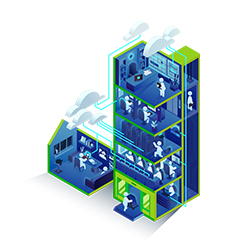Author: Angad Soni
Chief Architect, Business Applications & Data Modernization
Long View
For some time now, there has been a growing interest in understanding how AI will influence our lives at work. This need not be fueled by a fear of a dystopian future where robots take over, but should take a more nuanced perspective, starting with the impact on the individual and extending to the impact on the organization.
Consider the future of Company X. What will it look like in a few years? Will traditional departments and roles still exist? While the answers are uncertain, what is clear is that work environments are evolving – we’ve heard the phrase "it's not AI that will replace you, but someone using AI.’ It's important to recognize the central role of humans – you, we, they, people – in this transformation. Ignoring this would be an oversight.
On an individual level, let's take the example of working in the finance department of Company X. A role as an accounts payable clerk involves repetitive tasks, ensuring timely and accurate payments. But there’s also potential for individuals to go beyond routine. Ambitious exploration, pattern recognition, and analysis can lead to uncovering irregularities, emphasizing the role of the human touch in problem-solving.
Now let’s fast forward to a scenario where companies widely adopt AI. Collaborating with an AI model doesn't merely involve posting information and completing tasks; it enhances efficiency, saves costs, and poses insightful questions. Each team member uses the same AI model but tailors it to themselves, based on individual experiences and perspectives, ‘teaching’ it over time to recognize patterns and solve problems. This hybrid team becomes an asset, creating a unique advantage for each member when they combine with their AI models.
The future workplace consists of departments of individuals supported by AI, who share their individual successes with the larger group to improve the models over time. Some of the more repetitive functions are eventually replaced entirely by AI, but the organization of the future still consists of a diverse group of employees, allowing new ideas to grow and flourish, and creating an environment rich in innovation.
The employee base now has the bandwidth to be much more creative and strategic in their area of expertise as they are supported by personal AI copilots. This also poses new risk: information hoarding. Organizations then face the dilemma of sharing information versus being seen as invasive. How can this be managed?
The answer is a tiered model. An employee plugs into the organization’s network, connecting them with the rest of the organization. When plugged in their model will share net-new company related questions, answers, insights to a larger departmental model. The highest-level organizational model is fed information from departmental models, which have been built by the individual employees and their AI models.
"The Silent ‘H’ in AI" isn't just a peek into the future of work with AI. It's a real, down-to-earth look at how things are changing, both for individuals and for organizations. Instead of clocking into the same old role every day, our roles are getting an upgrade – we get the opportunity to act as ‘detectives’ in our roles, spotting things AI might miss.
It’s the human touch – that ‘H’ in AI – that makes the difference. Employees aren’t being replaced – rather, they’re being given some powerful tools that make their work smarter, faster, and more interesting. At the same time companies are growing, driving innovation, and getting better at what they do.
Looking forward, we shouldn’t be ruled by fear or complexity. We should see the opportunity to team up with AI to make our jobs cooler, more interesting, and to make our companies smarter. We're stepping into a future where work isn't just work – it’s a place where our human intelligence and creativity, combined with AI's capabilities, do amazing things.
“A computer can never be held accountable. Therefore, a computer should never make management decisions.”
Areas we will explore in the future:
AI’s limitations and challenges: Despite its prowess, AI isn’t without its limitations. There are nuances in human emotions and ethical decision-making that AI struggles with. The challenge lies in marrying AI's computational power with the irreplaceable depth of human understanding.
Future trends and predictions: Looking ahead, we anticipate a surge in AI innovation. From AI that can mimic human empathy to algorithms that can predict market trends with uncanny accuracy, the future workplace might look like something straight out of a science fiction novel.
Employee engagement and adaptation: Employees are responding to AI in diverse ways. While some embrace these changes, upskilling themselves enthusiastically, others are cautiously optimistic, mindful of the challenges and opportunities AI brings.
Management and leadership in the AI era: In this evolving landscape, management and leadership styles are adapting. Leaders are now focusing on guiding their teams through the AI transition, fostering a culture of innovation and resilience.
… and much more.

Subscribe to our newsletter for the latest updates.